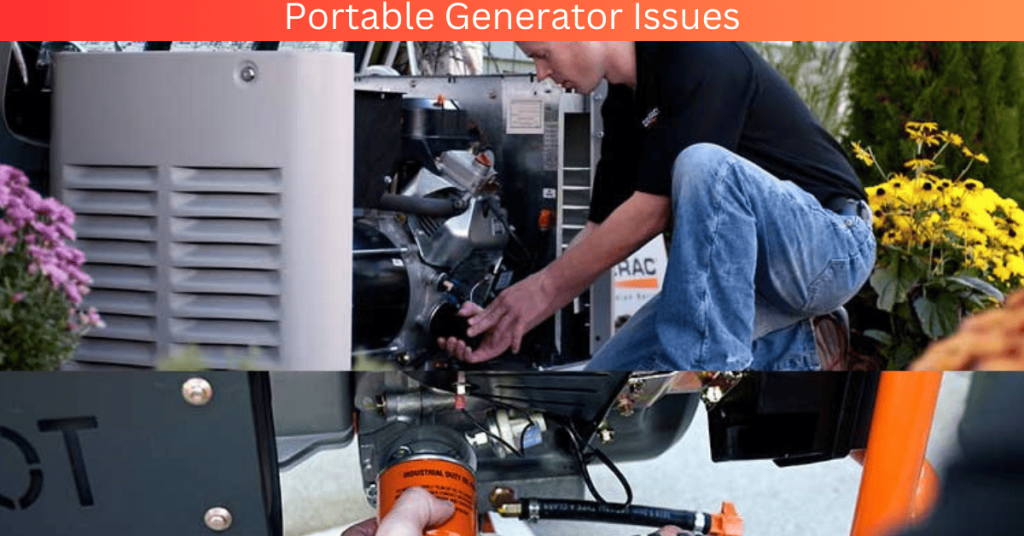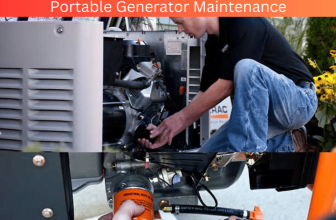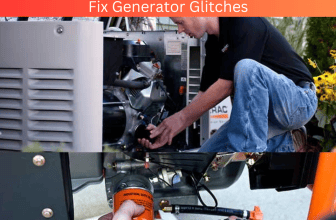Welcome fellow DIY enthusiasts! Are you struggling with your portable generators subpar performance? You’re not alone. Many others experience similar difficulties with their machines. It can be frustrating trying to pinpoint where exactly things went wrong regarding its operation but fret not!

In this article, I’ll take through some trouble shooting tips that will help identify common issues that plague most portable generators and provide a comprehensive guide on fixing them quickly for optimal performance restoration.
These include fuel supply problems, engine misfires, and battery related issues. So if you’re looking for an easy and efficient way of getting your generator back up to full capacity then continue reading!
Fuel Delivery Problems
Our reliance on portable generators cannot be overstated. They serve as lifelines in times of need and provide valuable creature comforts in remote areas. Yet, time has taught us that even the most reliable devices can inevitably malfunction or fail due to fuel delivery problems. Fuel-related issues like clogged jets, aging carburetors or bad gasoline are among some of the more common culprits affecting performance.
So how can we ensure that our generators remain reliable? Start by carefully examining both the spark plug and air filter for any signs of dirtiness or obstruction; cleaning them may solve minor issues right off the bat.
From there, move on to exploring potential blockages within the fuel line or filter. If present clear them out with immediate effect. If you still experience difficulties starting up your generator then perhaps its carburetor needs to be inspected for potential issues.
Soaking the jets using the right cleaner solution can help resolve your issues and avoid more costly solutions. By staying ahead of fuel delivery issues with your portable generator you’ll never be caught off guard when you need power most!
Engine Misfires

Encountering engine misfires on your generator can be an unwelcome development.
It’s imperative to act quickly and resolve any issues for optimal functioning of your device. Begin by examining the spark plug for debris or corrosion before proceeding to evaluate the fuel filter for obstructions if the spark plug appears fine. Finally, examine the air filter and determine whether it requires replacement.
In instances of electrical issues on your portable generator battery-related concerns serve as a potential focus area for troubleshooting purposes. Start by checking all battery connections ensuring each are secure. Consider cleaning off terminal corrosion with a brush and baking soda solution before moving forward.
Battery Issues
Portable generators are incredibly useful until they run low on battery due to various issues. Outages can happen unpredictably and having your generator suddenly stop working just compounds them further. That being said, diagnosing and fixing battery related problems isn’t as daunting a task as it may seem.
Start by checking if all of the terminals are appropriately connected before diving deeper into troubleshooting potential complications with the machine itself. One should use appropriate monitoring devices such as multimeters or similar tools to get precise voltage measurements for their batteries that usually lie within ranges between 12 14 volts (not charged) and 13 15 volts (while charging).
If following those steps does not alleviate this issue then there could potentially be more technically oriented challenges being faced with regards to equipment failure that require professional expertise for resolution. With a dedicated approach towards early identification & precision based adjustments being carried out professionally. Lasting performance should hopefully be expected!
Spark Plug Issues

Are you having trouble getting your portable generator to run smoothly? One of the most common culprits behind this issue is spark plug issues. Fortunately, checking and replacing your spark plugs is an easy fix that can greatly improve your generator’s performance.
To get started, locate your spark plugs by removing both the air filter cover and filter itself. Once you have access to them, take out each plug and examine its condition. If they look worn or discolored at all then they need to be replaced. Luckily, replacement spark plugs are widely available at automotive parts stores.
However, before installing them make sure that you thoroughly clean off any old residue from their threads with a wire brush. This will help ensure a tight seal when screwing in each new plug.
Finally, reinstall both the air filter components and start up your generator once again. With fresh new spark plugs installed correctly, we’re confident that you’ll notice a significant improvement right away.
Air Filter Clogs
If you rely on a portable generator for backup power or outdoor activities, you know how important it is to keep it running smoothly. Unfortunately, even well-maintained generators can experience issues – like a clogged air filter. A dirty air filter can limit airflow to your generator’s engine and cause it to behave erratically or shut down altogether.
Luckily, solving this issue doesn’t require advanced mechanical skills. The first step is locating the elusive air filter which could be tucked away near the fuel tank or situated prominently at the top of the engine depending on your machines design. Once you locate it, grab hold and pull out carefully checking for any dirt build up affecting its efficiency along with other debris that has made its way inside creating issues for your generator.
If you notice a clogged filter, don’t worry. Simply replace it with a new one which is readily available at your local store or online. In summary, here are the steps on how to handle the problem:
| Steps | Description |
|---|---|
| Step 1 | Find air filter |
| Step 3 | Check for debris |
| Step 4 | Replace if necessary |
Your portable generator should be running smoothly again once you follow these steps and replace your air filter. Remember to perform routine checks and maintenance to avoid future issues like this in order to be fully prepared for any eventuality.
Our next subject demands our concentration: low coolant levels. It’s a pressing concern that calls for immediate action and thorough analysis.
Low Coolant Levels
Is low coolant levels causing issues for your generator? This issue is pretty common but what triggers such occurrences?
You might think that fixing this problem requires nothing more than patching up radiator leaks or hose leaks, which is possible in some cases, but it is necessary to pinpoint precisely where the leak originates if that’s indeed what is going on inside your generator. Not topping off fluids regularly enough could also result in evaporation over time due to heat exposure. So, don’t forget about maintenance operations! If there are no signs of leaks and topping off fluids doesn’t solve anything either then an old thermostat might need replacement – as it regulates how much cool fluid flows through the system keeping things consistent when working well.
Typically, replacing a thermostat entails only short term effort depending on make/model specifications but should always be performed by someone who knows exactly what they’re doing performance wise! And finally, if all else fails you might need to recruit the help of a trained technician who can check for underlying issues within your generator system.
It is essential to cover all bases before shelling out cash for repairs. By ruling out potential culprits you’ll avoid wasting money on unnecessary fixes and prevent additional damage.
Turning our focus to the subject of ignition coil issues this is a prevalent concern for those who use portable generators.
Ignition Coil Issues

We’ve all been there – attempting to deal with a finicky generator while feeling our frustration levels skyrocket. One of the most frequent hiccups? Issues related to ignition coils which can fail entirely or simply refuse to spark properly.
You’ll be happy to learn, however, that theres no reason for doom and gloom. With an abundance of patience and basic knowledge under your belt fixing this issue yourself is absolutely feasible!
Start first by inspecting wire connections closely. Using a multimeter will allow you to test for proper continuity between each wire accurately. Any disruptions in continuity could indicate one or more faulty wires requiring replacement pronto- don’t forget perusing precisely manufacturer guidelines when reconnecting post replacement!
Next up: scrutinize your spark plug carefully! Keep an eye out for wear and tear damage. If necessary, immediately replace it alongside clearing out debris from inside its hole which could obstruct smooth running over time. A reliable generator can be an essential tool during power outages or outdoor expeditions—but what do you do when it stops working? Before going down the route of calling in expert help consider giving these three troubleshooting steps a whirl:
Step 1 – involves testing each wires continuity with a multimeter replacing any bad wires detected during this process then reconnecting everything according to manufacturer instructions.
Step 2 – We suggest checking for wear and tear on your spark plug. Clean out any dirt or debris found in the hole while assessing whether it needs replacement entirely.
Finally, we arrive at Step 3 where attention is given towards making sure each connection is secure before going ahead with attempting to start your generator again.
By taking these necessary steps you could soon have a generator that runs as efficiently as ever. Don’t give up hope, instead try these troubleshooting tips and see if your trusty machine bounces back!
Fuel Leaks
Now that we’ve touched upon ignition coil issues and relevant solutions let’s delve into another problem- fuel leaks. These are exasperating because if not taken care of quickly and efficiently, they can result in significant damage.
To begin diagnosing these issues, one needs to identify what’s causing them. This is often not an easy task and may require an extensive checkup whereby one inspects the generator’s entire system which includes but is not limited to. It’s fuel lines, connections, tank and cap.
It’s vital that you repair or replace any corroded or damaged parts immediately when found because ignoring these issues could lead towards even bigger concerns later on down the line.
Checking for visible wear or deterioration on the fuel filter should also be on your checklist before proceeding with regular operation & maintenance tasks such as replacing it every so often too! Ensuring preventive measures like this will keep things running like clockwork thus avoiding unwanted future surprises like fuel leaks.
Oil Leaks

Oil leaks are every generator owners nightmare. It is frustrating, and when left unchecked, it could cause severe damage and loss of money invested! Identifying where exactly its leaking from should be your priority when attempting to fix this problem.
Often solving oil leaks merely requires essentials like tightening loose connections or replacing worn out gaskets or O rings. But sometimes fixing these types of leaks might require deeper intervention by replacing some parts.
It is important to react to oil leakage sooner rather than later because ignoring it over time could lead to costly damages that might prove hard to fix.
Alternatively, regular maintenance checks prevent these types of complications from happening in the first place! So lets dig in and work out how best we can approach resolving clogged fuel lines today!
Clogged Fuel Lines
Clogged up fuel lines? It is one headache every generator owner hates dealing with. But relax! We’ve got you covered with this section guiding you through how to address this problem quickly and easily without spending lots on repairs.
Let us start by examining the symptoms and causes of a clogged fuel line issue. If a reduced flow of gas is causing difficulty starting or running your generator then it may be due to either a blocked filter or fuel line that prevents enough fuel from reaching the engine leading to decreased performance. To solve this issue hassle free you will need to clear any debris blocking your fuel line first followed by cleaning or replacing both the filter and line as required. You should also check for leaks in either tank or carburetor. Replace if necessary along with adjusting your air fuel mixture.
If you’re looking forward to powering up your generator successfully without encountering any hitches along the way then first things first. Inspect both the tank and carburetor respectfully checking for leaks if present before proceeding further. A further scrutiny should also be conducted on the carburetor in order to detect any filth or obstructions which may hamper proper functioning. If replacements are required due wear and tear then go ahead and replace with fresh parts without forgetting a new gasket too.
The final step involves making an adjustment on air fuel mixture where necessary until optimal performance is achieved. Once all these measures have been carried out in sequence you can now bid farewell to those pesky clogged fuel lines that may have been the source of your troubles.
Frequently Asked Questions
How Often Should I Change The Generator’S Oil?
If ther’es one vital aspect when it comes to maintaining a steady power source – it has got to be tending correctly to its heart -oil! Experts suggest replacing the lubricant after every 50 100 operating hours or at least once a year for maximum efficacy.
However, using synthetic oils can offer a more prolonged viability of 150 200 hours between replacements. The key to ensuring your device runs seamlessly is keeping an eye on the run time and adhering to its maintenance schedule without fail.
This way, you’ll safeguard your generators smooth operation and long lasting power output for years on end.
How Do I Know When To Replace The Spark Plugs?
To keep your generator purring along nicely requires continuous attention and upkeep – including timely replacement of its spark plugs when needed. Knowing exactly when this replacement should occur isn’t always obvious though – but there are indicators that can assist you in deciding whether swapping them out would be wise. Physical damage such as corrosion or clogging, uneven engine power output, increased difficulty starting up – all point towards changing the old fuel sparkers for new ones!
By being mindful of these warning signs any potential issues with your generator will be addressed sooner rather than later saving you from a potential headache.
Is It Safe To Use The Generator In Wet Weather?
When operating a generator taking preemptive measures is crucial for maintaining maximum safety levels—especially when theres inclement weather involved. It is wise not to use your generator in wet conditions as this raises significant concerns around electrical components being damaged by water exposure.
Not only does this increase the likelihood of short circuits but also may trigger fires that pose serious threats to both individuals and property alike.
Furthermore, using generators in damp environments runs the risk of malfunctions occurring that could lead to dangerous fumes being released into vulnerable surroundings; thus keeping your appliance dry at all times is essential for mitigating these risks.
What Is The Best Way To Store A Generator For Long Periods Of Time?
When attempting to store a generator for an extended period successfully, one must implement specific precautions beforehand properly.
Failure to do so may impact its lifespan drastically – causing mayhem when needed most! Firstly, consider cleaning all exterior parts appropriately by removing any dirt accumulation or debris before storage occurs; otherwise leaving them unmaintained may cause costly damages over time.
Proper draining of fuel from both tank and carburetor is also necessary during this process as rusting could occur due to buildup within vital engine components otherwise! Finally, ensure adequate ventilation when choosing where best suits storing purposes – avoiding unwanted moisture accumulation while keeping it safe until use again.
How Can I Tell If The Generator Is Overloaded?
The process of determining whether or not a power generator is overloaded can be tricky business. This is especially true when powering numerous appliances and tools simultaneously because each device has its unique wattage rating to take into account.
If the total combined watts exceed what the power source offers, then, there could be an overloading problem at hand. Telltale signs include hearing an odd humming sound originating from your generator or having it shut down unexpectedly altogether.
To resolve issues like this, efficiently and swiftly unplugging certain devices in use can help reduce pressure on your machine.
Conclusion
There are few things in life more frustrating than discovering that an important tool has failed us at a critical moment—such as when our trusty portable generator sputters out during an unexpected power outage! But with proper maintenance techniques we can make sure this never happens again.
One simple step towards keeping our generators working well includes regularly changing both oil and spark plugs—a preventative measure that requires minimal effort yet yields great results.
Other tips include carefully storing our machines during prolonged periods of disuse and avoiding overloading them with too much power usage.
Even weather conditions can play a role in ensuring our generators function properly so its important to be mindful of this as well. By dedicating just a little bit of time toward maintenance we can ensure our portable generators never let us down during an emergency!






